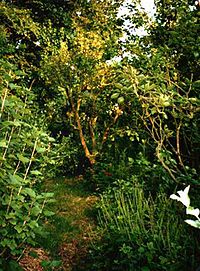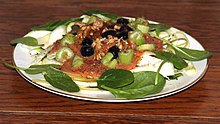Raw veganism: Difference between revisions
Bon courage (talk | contribs) →Research on vegan diets: not specific to "raw"; covered better at Veganism |
Hawaiisunfun (talk | contribs) it doesn't need the part about 'processed or altered', as just chopping food is that - and that's still raw vegan. Added more history and grammar. Please don't delete. |
||
| Line 1: | Line 1: | ||
{{merge|Raw foodism|discuss=Talk:Raw veganism#Merger proposal|date=July 2020}} |
{{merge|Raw foodism|discuss=Talk:Raw veganism#Merger proposal|date=July 2020}} |
||
{{Medical citations needed|date=July 2020}} |
{{Medical citations needed|date=July 2020}} |
||
{{short description|Type of human diet}}[[File:Forestgarden2.jpg|thumb|200px|[[Robert Hart (horticulturist)|Robert Hart]]'s [[forest gardening|forest garden]] in Shropshire, England]]'''Raw veganism''' is a diet that combines the concepts of [[veganism]] and [[raw foodism]]. It excludes all food and products of [[Animal product|animal origin]], any food |
{{short description|Type of human diet}}[[File:Forestgarden2.jpg|thumb|200px|[[Robert Hart (horticulturist)|Robert Hart]]'s [[forest gardening|forest garden]] in Shropshire, England]]'''Raw veganism''' is a diet that combines the concepts of [[veganism]] and [[raw foodism]]. It excludes all food and products of [[Animal product|animal origin]], any food cooked at high temperatures. Raw veganism has rarely been practiced in history,<ref name="fontana">{{Cite journal|last=Fontana|first=Luigi|last2=Shew|first2=Jennifer L.|last3=Holloszy|first3=John O.|last4=Villareal|first4=Dennis T.|date=2005-03-28|title=Low Bone Mass in Subjects on a Long-term Raw Vegetarian Diet|journal=Archives of Internal Medicine|language=en|volume=165|issue=6|pages=684–9|doi=10.1001/archinte.165.6.684|pmid=15795346|issn=0003-9926|doi-access=free}}</ref> but it has become more of a trend recently.<ref>{{Cite journal|last=Kamiński|first=Mikołaj|last2=Skonieczna-Żydecka|first2=Karolina|last3=Nowak|first3=Jan Krzysztof|last4=Stachowska|first4=Ewa|date=2020-02-12|title=Global and local diet popularity rankings, their secular trends and seasonal variation in Google Trends data|url=http://www.sciencedirect.com/science/article/pii/S0899900720300423|journal=Nutrition|language=en|pages=110759|doi=10.1016/j.nut.2020.110759|issn=0899-9007}}</ref> |
||
==History== |
==History== |
||
Germans brought raw veganism to Southern California in the 1800s.<ref>{{Cite journal|last=Link|first=Lilli B.|last2=Jacobson|first2=Judith S.|date=2008-2|title=Factors affecting adherence to a raw vegan diet|url=https://www.ncbi.nlm.nih.gov/pmc/articles/PMC3635096/|journal=Complementary therapies in clinical practice|volume=14|issue=1|pages=53–59|doi=10.1016/j.ctcp.2006.12.005|issn=1744-3881|pmc=3635096|pmid=18243943}}</ref> Raw Food Dining Room, the world's first raw vegan restaurant (no longer in existence), was opened in Los Angeles, California in 1918 by [[John and Vera Richter]]<ref name="mearesLAW1mar2017">{{cite web|last1=Meares|first1=Hadley|date=6 June 2020|title=L.A. Has Been Eating Raw Vegan Food Since 1918, Thanks to This Communist, Feminist Angeleno|url=https://www.laweekly.com/l-a-has-been-eating-raw-vegan-food-since-1918-thanks-to-this-communist-feminist-angeleno/|url-status=live|archive-url=|archive-date=|accessdate=19 February 2019|website=}}</ref>. |
|||
[[Robert Hart (horticulturist)|Robert Hart]] practiced raw veganism from forest gardening as a food production system based on [[woodland]] [[ecosystem]]s incorporating [[fruit]] and [[Nut (fruit)|nut]] [[tree]]s, [[shrubs]], [[herb]]s, [[vine]]s, and [[perennial vegetable]]s.<ref>{{cite book|title=Forest Gardening|author=Robert Hart|date=1996|page=|url=https://books.google.com/books?id=N01940btQAQC&lpg=PA1|isbn=978-1603580502|publisher=Chelsea Green Publishing}}</ref><ref>{{cite book|title=How to Make a Forest Garden|author=Patrick Whitefield|date=2002|page=5|url=https://books.google.com/books?id=3rd3e69BnC8C&printsec=frontcover&dq#v=onepage|isbn=978-1856230087|publisher=Permanent Publications}}</ref> Forest gardens are a resilient [[agroecosystem]].<ref>{{cite book |title=The Forest Farms of Kandy: And Other Gardens of Complete Design|author=Douglas John McConnell |date=2003 |page=1 |url=https://books.google.com/books?id=QYBSfUJPQXcC&lpg=PA1|isbn=978-0754609582|publisher=Ashgate}}</ref> |
[[Robert Hart (horticulturist)|Robert Hart]] practiced raw veganism from forest gardening as a food production system based on [[woodland]] [[ecosystem]]s incorporating [[fruit]] and [[Nut (fruit)|nut]] [[tree]]s, [[shrubs]], [[herb]]s, [[vine]]s, and [[perennial vegetable]]s.<ref>{{cite book|title=Forest Gardening|author=Robert Hart|date=1996|page=|url=https://books.google.com/books?id=N01940btQAQC&lpg=PA1|isbn=978-1603580502|publisher=Chelsea Green Publishing}}</ref><ref>{{cite book|title=How to Make a Forest Garden|author=Patrick Whitefield|date=2002|page=5|url=https://books.google.com/books?id=3rd3e69BnC8C&printsec=frontcover&dq#v=onepage|isbn=978-1856230087|publisher=Permanent Publications}}</ref> Forest gardens are a resilient [[agroecosystem]].<ref>{{cite book |title=The Forest Farms of Kandy: And Other Gardens of Complete Design|author=Douglas John McConnell |date=2003 |page=1 |url=https://books.google.com/books?id=QYBSfUJPQXcC&lpg=PA1|isbn=978-0754609582|publisher=Ashgate}}</ref> |
||
| Line 14: | Line 14: | ||
===Contamination=== |
===Contamination=== |
||
[[Foodborne illness|Food-borne]] outbreaks of [[bacteria]]l, [[virus|viral]] or [[parasite|parasitic]] |
[[Foodborne illness|Food-borne]] outbreaks of [[bacteria]]l, [[virus|viral]] or [[parasite|parasitic]] origin, [[Zoonosis|zoonotic]] or human,<ref>{{Cite web|last=|first=|date=|title=Salmonella and Tomatoes|url=https://www.ars.usda.gov/ARSUserFiles/np108/SalmonellaSummit/SalmonellaTomatoes%282%29.pdf|url-status=live|archive-url=|archive-date=|access-date=7 June 2020|website=U.S. Department of Agriculture}}</ref> are caused by consumption of [[microorganism]]-[[contamination|contaminated]] raw herbs and spices,<ref>{{cite web|title=Risk Profile: Pathogens and Filth in Spices|url=https://www.fda.gov/food/foodscienceresearch/risksafetyassessment/ucm367339.htm|accessdate=15 December 2018|publisher=US Food and Drug Administration}}</ref> fruits, vegetables, or other plant foods.<ref name="nih2010">{{cite web | title=Foodborne illnesses | publisher=National Institute of Diabetes and Digestive and Kidney Diseases, US National Institutes of Health | date=2010-02-01 | url=https://www.niddk.nih.gov/health-information/digestive-diseases/foodborne-illnesses | access-date=2018-12-16}}</ref><ref name="Erickson2011">{{cite web | last=Erickson | first=Marilyn C. | last2=Doyle | first2=Michael P. | title=Plant food safety issues: Linking production agriculture a one health approach: Workshop summary|publisher=US Institute of Medicine; Washington (DC): National Academies Press| date=2012 | url=https://www.ncbi.nlm.nih.gov/books/NBK114507/ | access-date=2018-12-16}}</ref> The US [[Food and Drug Administration]] recommends cooking when possible to kill microorganisms in raw plant foods.<ref>{{cite web|title=Rarely Consumed Raw Produce. Produce Safety Rule (21 CFR 112)|url=https://www.fda.gov/downloads/food/guidanceregulation/fsma/ucm576496.pdf|accessdate=15 December 2018|publisher=US Food and Drug Administration}}</ref><ref>{{cite web|title=What the Produce Safety Rule Means for Consumers|url=https://www.fda.gov/Food/GuidanceRegulation/FSMA/ucm472503.htm|accessdate=15 December 2018|publisher=US Food and Drug Administration}}</ref> |
||
===Adulteration=== |
===Adulteration=== |
||
[[Adulterant|Adulteration]] is a concern for spices that are imported from locations with substandard regulations for hygienic food preparation.<ref name="fao">{{cite web |title=Code of Hygienic Practice |url=http://www.fao.org/fao-who-codexalimentarius/sh-proxy/en/?lnk=1&url=https%253A%252F%252Fworkspace.fao.org%252Fsites%252Fcodex%252FStandards%252FCAC%2BRCP%2B1-1969%252FCXP_001e.pdf |publisher=United Nations, Food and Agriculture Organization|accessdate=15 December 2018}}</ref> Cooking may not eliminate adulterants |
[[Adulterant|Adulteration]] is a concern for spices that are imported from locations with substandard regulations for hygienic food preparation.<ref name="fao">{{cite web |title=Code of Hygienic Practice |url=http://www.fao.org/fao-who-codexalimentarius/sh-proxy/en/?lnk=1&url=https%253A%252F%252Fworkspace.fao.org%252Fsites%252Fcodex%252FStandards%252FCAC%2BRCP%2B1-1969%252FCXP_001e.pdf |publisher=United Nations, Food and Agriculture Organization|accessdate=15 December 2018}}</ref> Cooking may not eliminate adulterants.<ref name=fao/><ref name="kumar">{{cite journal | last=Kumar | first=Pradeep | last2=Mahato | first2=Dipendra K. | last3=Kamle | first3=Madhu | last4=Mohanta | first4=Tapan K. | last5=Kang | first5=Sang G. | title=Aflatoxins: A Global Concern for Food Safety, Human Health and Their Management | journal=Frontiers in Microbiology | volume=07 | pages=2170 | date=2017-01-17 | issn=1664-302X | pmid=28144235 | pmc=5240007 | doi=10.3389/fmicb.2016.02170}}</ref> |
||
==See also== |
==See also== |
||
Revision as of 13:50, 1 August 2020
It has been suggested that this article be merged with Raw foodism. (Discuss) Proposed since July 2020. |
This article needs more reliable medical references for verification or relies too heavily on primary sources. (July 2020) |  |

Raw veganism is a diet that combines the concepts of veganism and raw foodism. It excludes all food and products of animal origin, any food cooked at high temperatures. Raw veganism has rarely been practiced in history,[1] but it has become more of a trend recently.[2]
History
Germans brought raw veganism to Southern California in the 1800s.[3] Raw Food Dining Room, the world's first raw vegan restaurant (no longer in existence), was opened in Los Angeles, California in 1918 by John and Vera Richter[4].
Robert Hart practiced raw veganism from forest gardening as a food production system based on woodland ecosystems incorporating fruit and nut trees, shrubs, herbs, vines, and perennial vegetables.[5][6] Forest gardens are a resilient agroecosystem.[7]

Concerns
The British Dietetic Association named the raw vegan diet one of the "top 5 worst celeb diets to avoid in 2018", raising a concern that it could compromise long-term health.[8]
Contamination
Food-borne outbreaks of bacterial, viral or parasitic origin, zoonotic or human,[9] are caused by consumption of microorganism-contaminated raw herbs and spices,[10] fruits, vegetables, or other plant foods.[11][12] The US Food and Drug Administration recommends cooking when possible to kill microorganisms in raw plant foods.[13][14]
Adulteration
Adulteration is a concern for spices that are imported from locations with substandard regulations for hygienic food preparation.[15] Cooking may not eliminate adulterants.[15][16]
See also
References
- ^ Fontana, Luigi; Shew, Jennifer L.; Holloszy, John O.; Villareal, Dennis T. (2005-03-28). "Low Bone Mass in Subjects on a Long-term Raw Vegetarian Diet". Archives of Internal Medicine. 165 (6): 684–9. doi:10.1001/archinte.165.6.684. ISSN 0003-9926. PMID 15795346.
- ^ Kamiński, Mikołaj; Skonieczna-Żydecka, Karolina; Nowak, Jan Krzysztof; Stachowska, Ewa (2020-02-12). "Global and local diet popularity rankings, their secular trends and seasonal variation in Google Trends data". Nutrition: 110759. doi:10.1016/j.nut.2020.110759. ISSN 0899-9007.
- ^ Link, Lilli B.; Jacobson, Judith S. (2008-2). "Factors affecting adherence to a raw vegan diet". Complementary therapies in clinical practice. 14 (1): 53–59. doi:10.1016/j.ctcp.2006.12.005. ISSN 1744-3881. PMC 3635096. PMID 18243943.
{{cite journal}}: Check date values in:|date=(help) - ^ Meares, Hadley (6 June 2020). "L.A. Has Been Eating Raw Vegan Food Since 1918, Thanks to This Communist, Feminist Angeleno". Retrieved 19 February 2019.
{{cite web}}: CS1 maint: url-status (link) - ^ Robert Hart (1996). Forest Gardening. Chelsea Green Publishing. ISBN 978-1603580502.
- ^ Patrick Whitefield (2002). How to Make a Forest Garden. Permanent Publications. p. 5. ISBN 978-1856230087.
- ^ Douglas John McConnell (2003). The Forest Farms of Kandy: And Other Gardens of Complete Design. Ashgate. p. 1. ISBN 978-0754609582.
- ^ "Top 5 worst celeb diets to avoid in 2018". British Dietetic Association. 7 December 2017.
The British Dietetic Association (BDA) today revealed its much-anticipated annual list of celebrity diets to avoid in 2018. The line-up this year includes Raw Vegan, Alkaline, Pioppi and Ketogenic diets as well as Katie Price's Nutritional Supplements.
- ^ "Salmonella and Tomatoes" (PDF). U.S. Department of Agriculture. Retrieved 7 June 2020.
{{cite web}}: CS1 maint: url-status (link) - ^ "Risk Profile: Pathogens and Filth in Spices". US Food and Drug Administration. Retrieved 15 December 2018.
- ^ "Foodborne illnesses". National Institute of Diabetes and Digestive and Kidney Diseases, US National Institutes of Health. 2010-02-01. Retrieved 2018-12-16.
- ^ Erickson, Marilyn C.; Doyle, Michael P. (2012). "Plant food safety issues: Linking production agriculture a one health approach: Workshop summary". US Institute of Medicine; Washington (DC): National Academies Press. Retrieved 2018-12-16.
- ^ "Rarely Consumed Raw Produce. Produce Safety Rule (21 CFR 112)" (PDF). US Food and Drug Administration. Retrieved 15 December 2018.
- ^ "What the Produce Safety Rule Means for Consumers". US Food and Drug Administration. Retrieved 15 December 2018.
- ^ a b "Code of Hygienic Practice" (PDF). United Nations, Food and Agriculture Organization. Retrieved 15 December 2018.
- ^ Kumar, Pradeep; Mahato, Dipendra K.; Kamle, Madhu; Mohanta, Tapan K.; Kang, Sang G. (2017-01-17). "Aflatoxins: A Global Concern for Food Safety, Human Health and Their Management". Frontiers in Microbiology. 07: 2170. doi:10.3389/fmicb.2016.02170. ISSN 1664-302X. PMC 5240007. PMID 28144235.
{{cite journal}}: CS1 maint: unflagged free DOI (link)
